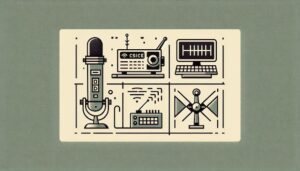A Guide to Voice, Morse Code, Digital Modes, and Satellite Operations
In the dynamic world of amateur radio, mastering diverse communication techniques is essential for every ham operator. This comprehensive guide dives deep into the various methods of communication available to Technician Class operators, including voice transmission, Morse code (CW), digital modes, and satellite communication. Whether you’re a novice eager to set up your first station or a seasoned enthusiast looking to expand your communication repertoire, understanding these fundamental techniques is crucial for successful and enjoyable ham radio experiences.
#1. Which digital mode is designed for real-time text communication?
#2. For satellite communication, what is an important consideration when setting up an antenna system?
Antennas for satellite work often need to be directional with the ability to rotate and elevate to track satellites across the sky.
Results
The realm of amateur radio is a vast and versatile field, offering multiple avenues for enthusiasts to explore and communicate. Whether it’s for emergency response, hobby, or scientific research, understanding the various communication methods within the Technician Class license can significantly enhance your experience. This blog post aims to shed light on the core communication methods in ham radio: voice, Morse code (CW), digital modes, and satellite communication, providing insights and practical advice for both newcomers and seasoned operators.
Voice Communication: The Human Touch in Radio Waves
Voice communication remains the most intuitive method for many ham radio enthusiasts. It allows for direct, real-time interaction using FM (Frequency Modulation) and SSB (Single Sideband) modes, commonly used on VHF (Very High Frequency) and UHF (Ultra High Frequency) bands, as well as HF (High Frequency) bands, respectively. FM is preferred for its simplicity and clarity, making it ideal for local and regional communications. On the other hand, SSB, used primarily on HF bands, enables long-distance communication by using bandwidth more efficiently.
For beginners eager to start with voice communication, investing in a reliable dual-band VHF/UHF transceiver would be a prudent first step. This enables participation in local nets and emergency communication services, offering a practical way to hone your operating skills.
Morse Code (CW): Bridging Continents with Dots and Dashes
Morse code, an age-old method of communication, continues to be revered within the ham radio community for its simplicity and efficiency. Representing letters and numbers through a series of dots (short signals) and dashes (long signals), CW (Continuous Wave) can make long-distance contacts with relatively low power. This mode is not only about tradition; it’s highly practical in scenarios where voice communication might be hindered by noise or weak signals.
Learning Morse code requires patience and practice. Start with familiarizing yourself with the Morse alphabet and progressively practice receiving and sending Morse code. Various online tools and apps offer interactive learning experiences, making this seemingly daunting task more accessible.
Digital Modes: The Future of Text Communication
Digital modes like FT8, JT65, and PSK31 have transformed amateur radio by facilitating efficient and reliable text communication, even under challenging conditions. These modes, particularly FT8, have gained popularity for their ability to decode signals well below the noise level, opening up new possibilities for making contacts.
To get started with digital modes, one needs a sound card interface between the computer and the transceiver, along with software like WSJT-X for FT8 or FLdigi for PSK31. This setup allows for a wide range of operations, from casual chatting to DXing and contesting.
Satellite Communication: Touching the Stars
Satellite communication represents one of the most thrilling aspects of amateur radio, allowing operators to make contacts through satellites orbiting the Earth. This method requires more specialized equipment, including directional antennas and software to track satellite paths.
Getting involved in satellite communication might seem daunting, but it’s highly rewarding. Starting with FM satellites (easy-sats) is recommended for beginners, as they only require a dual-band VHF/UHF transceiver and a simple handheld Yagi antenna.



